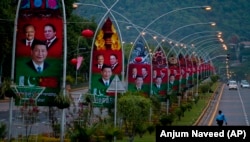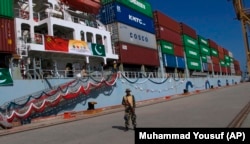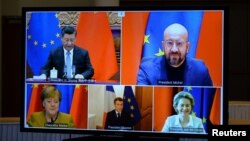Welcome back to the China In Eurasia briefing, an RFE/RL newsletter tracking China’s resurgent influence from Eastern Europe to Central Asia.
As you may have heard, the newsletter is now published twice a month. Expect it in your in-box on the first and third Wednesdays of each month. Subscribe here.
I’m RFE/RL correspondent Reid Standish and here’s what I’m following right now.
Beijing Scores An Own Goal In Europe
From a frozen investment pact with the European Union to Lithuania’s withdrawal from China’s chosen format for engaging with Central and Eastern Europe, Beijing found itself in damage-control mode the past few weeks across much of the continent.
Finding Perspective: China’s ambitious trade and investment deal with the EU is on ice -- and a thaw doesn’t look to be coming anytime soon.
The European Parliament passed a resolution on May 20 that would prevent a much-talked-about agreement from going into effect until China lifts sanctions it imposed on European lawmakers and institutions.
Those sanctions were a response to a long dispute over Beijing's treatment of its Uyghur minority and other Muslims in Xinjiang Province and sanctions imposed on China by Brussels in March.
As I reported earlier, the decision to freeze the deal signals a harder line developing towards China in Europe. Germany will hold elections in September that could bring in a tougher foreign policy toward Beijing, with the same holding true for the Czech Republic in October.
The opposition in Hungary is also seeking to unseat Prime Minister Viktor Orban in 2022, which, if successful, could see a reversal of Budapest’s current pro-China stance.
Meanwhile, Lithuania cemented its departure from the “17+1,” a format launched by China to engage with Central and Eastern European countries, which Foreign Minister Gabrielius Landsbergis told Politico was a divisive format. He urged other countries to join Vilnius in leaving.
Why It Matters: The region’s honeymoon with China may be long over, but that doesn’t mean that a divorce is in the cards.
On the one hand, the rising tensions with the EU are a far cry from the wedge that China managed to drive between Brussels and Washington while the bloc's relations were soured with the administration of U.S. President Donald Trump.
And judging from Beijing’s official reactions to the moves, repairs in its increasingly shaky relationship won’t come soon.
After news broke that the deal was being held up, China blamed the EU, with a Chinese Foreign Ministry spokesman saying Brussels should focus “less on emotional outbursts and more on rational thinking.”
This was followed by Foreign Minister Wang Yi attacking the EU for the human rights sanctions. Speaking via video link at the Munich Security Conference about accusations of genocide being conducted in Xinjiang, Wang said that “our European friends know what genocide is.”
But beyond the harsh words, Beijing was also quick to show that its grand strategy wasn’t completely derailed in the region.
China organized a series of high-profile meetings with Croatia, Hungary, Poland, Serbia, and Slovenia, with both Croatia and Poland providing official endorsements of Chinese engagement in the region and Serbia inking a series of cooperation deals.
Read More
- For a more detailed look at how China views Europe, listen to Bonnie S. Glaser’s interview with Professor Lanxin Xiang in her new podcast at the German Marshall Fund.
- China came unmoored from its grand strategy and its "wolf-warrior diplomacy" is largely to blame, argues Tufts University’s Sulmaan Wasif Khan in a piece for Foreign Policy magazine.
- After years of viewing China primarily as a lucrative market, Germany is in the process of rethinking its relationship with Beijing, writes Noah Barkin in a new report for Chatham House.
Experts' Corner: China Adjusts To An Erratic Lukashenka
Readers asked: “How does the recent plane incident in Belarus affect relations between Minsk and Beijing?”
“The recent plane incident in Belarus will do more to reshape, rather than disrupt, relations between Minsk and Beijing. As long as Minsk can meet Chinese credit and loan conditions, and Western sanctions don’t somehow interrupt Belarus’s eastward trade (the Lukashenka regime's links with Moscow make this practically impossible), then existing projects and trade with China will continue to develop, albeit at a less predictable pace.” -- Peter Braga, an expert on Belarus-China relations at University College London
“Beijing criticized European reactions to the [Belarusian plane] incident, referring to the hijacking as ‘an opinion, not a fact,’ and called the sanctions baseless. This verbal support does not change much in Lukashenka’s situation, though. China turned out to be a fair-weather friend, giving Russia a free hand in using Belarus’s problems to push for deeper integration.” -- Jakub Jakobowski, senior fellow at the Center For Eastern Studies in Warsaw
For some background about China and Belarus, read this article I wrote in March. And for more on Minsk’s grounding of the Ryanair flight and the abduction of opposition journalist Raman Pratasevich, follow RFE/RL’s ongoing coverage here.
Do you have a question about China’s growing footprint in Eurasia? Send it to me at StandishR@rferl.org or reply directly to this e-mail and I’ll get it answered by leading experts and policymakers.
Three More Stories From Eurasia
1. Testing The Defense Waters
Serbia spent $19.3 million on six Chinese military drones, according to an investigation by my colleague Milla Gjurgjeviq from RFE/RL’s Balkan Service.
The Details: The CH92-A drones were purchased by Belgrade in July 2020 and showcased at a press event by Serbian President Aleksandar Vucic.
The price for the drones, however, was not disclosed. Vucic refused to answer a question when asked about the cost, saying it was a “military secret.”
"This is common and has nothing to do with China, but these [drones] are really not expensive," Vucic said at the time.
But an investigation of the database of Serbia’s statistics office listed the $19.3 million figure for aircraft procured from China in 2020, with the drones being the only sale from China during that year.
For more details, watch this handy explainer video from RFE/RL.
A Foot In The Door: Beyond the price tag of the drones, the sale is significant as it represents China’s expansion into the European defense sector.
While Chinese military drones have shown up in conflicts in the Middle East and North Africa, the shipment to Serbia was Beijing’s first export of military aviation equipment into Europe.
According to a January report from the Royal United Services Institute (RUSI), China has been eyeing expansion into the European defense market for some time, but has been hampered by an EU arms embargo put in place in 1989 over Beijing’s crackdown on the Tiananmen Square protests.
Like with many other policy areas -- from education cooperation to surveillance technologies -- Serbia functions as a showcase on the EU’s doorstep for industries and initiatives that Beijing is looking to expand.
2. A Diplomatic Booster For Central Asia
China’s “vaccine diplomacy” has garnered headlines around the world, but how are Beijing’s efforts faring in neighboring Central Asia?
I’ll be exploring this on June 10 during a panel discussion hosted by George Washington University’s Central Asia Program.
Click the link here to register.
Background: While China’s five different vaccines have found growing footholds around the developing world -- especially across the Balkans, South Asia, and Africa -- Central Asia remains an interesting case study.
While Chinese shots are increasingly filling a void left in the global distribution of vaccines, trust in them in Central Asia is low, with Russia’s Sputnik V appearing to be the preferred injection for the region.
But production and supply of the Russian vaccine is slowing, leaving the region relying on the World Health Organization's COVAX program and, increasingly, a mix of Chinese shots to meet demand.
It’s a complicated area in which to apply the “vaccine diplomacy” strategy, in no small part because Tajikistan claims to have not registered a new COVID case since the start of the year and Turkmenistan says it has never had a single coronavirus infection -- despite evidence to the contrary.
There will be lots to dig into on the panel. Don’t forget to register.
3. The Road To Podgorica
Beijing is willing to offer Montenegro a grace period for the $1 billion loan it owes the Export-Import Bank of China for a controversial highway project that has left the small country in a dire financial situation, RFE/RL’s Balkan Service reported.
Mending Fences: The discussion came from a phone conversation between Montenegrin President Milo Dukanovic and Chinese leader Xi Jinping on May 26.
Dukanovic, who was prime minister when the highway project was signed in 2014, welcomed more Chinese investment into the country and discussed broad cooperation across several industries, from tourism to education.
Xi also mentioned the highway project and offered the possibility of a grace period being extended to Podgorica, which owes its first payments on the long-delayed highway in July.
Context: The mammoth price tag drew international attention earlier this spring when Montenegrin Deputy Prime Minister Dritan Abazovic requested the EU help the country repay its loan to China, which Brussels later rejected.
The project was controversial from its early days, with it receiving the green light from its Chinese backers and Dukanovic’s government despite previously failing two feasibility studies.
The highway is incomplete and has seen its estimated costs rise over time. China holds approximately one-quarter of Montenegro's total debt, which reached 103 percent of GDP last year.
Across The Supercontinent
Trolled: In an act of defiance, the municipality of Budapest has renamed the streets around the proposed site for Fudan University in Hungary to Dalai Lama Street, Uyghur Martyrs' Road, and Free Hong Kong Road, RFE/RL's Hungarian Service reported.
Home Production: The Serbian government has set aside around $19.5 million for the construction of a factory that will produce China’s Sinopharm vaccine, RFE/RL’s Balkan Service reported.
Eastern Promises: Hungarian Foreign Minister Peter Szijjarto also announced during a May 31 trip to China that Sinopharm would be produced in Hungary at a factory that is currently under construction, RFE/RL’s Hungarian Service reported.
Denied: Kazakhstan has officially refused to grant citizenship to three ethnic Kazakhs who fled China's Xinjiang region and crossed illegally into the neighboring country fearing they would be sent to an internment camp, my colleague Aigerim Toleukhanova from RFE/RL’s Kazakh Service reported.
Qaisha Aqan, Murager Alimuly, and Kaster Musakhanuly were all granted temporary refugee status in Kazakhstan, but that does not give them certain rights in the country, such as the ability to work. With a pathway to citizenship now denied, their futures remain uncertain.
Tête-à-Tête: Yang Jiechi, who leads China’s Central Committee for Foreign Affairs, was in Moscow from May 24-26 for security talks amid closer ties between Beijing and the Kremlin as they navigate a growing confrontation with the United States.
Ties That Bind: Belgrade and Beijing signed a series of agreements between their interior ministries on May 27 that will set up more joint exercises and training for combating terrorism and organized crime, RFE/RL’s Balkan Service reported.
A Bot Army: A seven-month investigation by the Associated Press found that an army of fake accounts have retweeted Chinese diplomats and state media tens of thousands of times, “covertly amplifying propaganda that can reach hundreds of millions of people.”
One Thing To Watch
Now that U.S. President Joe Biden has ordered the country’s intelligence agencies to intensify their efforts to look into the origins of COVID-19, the theory that the virus may have leaked from the Wuhan Institute of Virology is back in play.
Once written off as a conspiracy theory and politicized by the Trump administration, Biden is publicly entertaining the theory due to new information gathered by U.S. intelligence.
Most experts still believe that the virus emerged naturally from animals to humans, but China’s secrecy around the origins of COVID-19 has lent credence to alternatives.
In a recent letter to the journal Science, a group of 18 prominent scientists said both theories were possible and should be taken “seriously” until sufficient data is obtained.
Chinese officials have flat out rejected the idea of a lab leak, but with the Biden administration breathing new life into the theory, expect the war of words between Beijing and Washington over COVID-19’s origins to heat up again.
That’s all from me for now. Don’t forget to send any questions, comments, or tips that you might have to StandishR@rferl.org.









